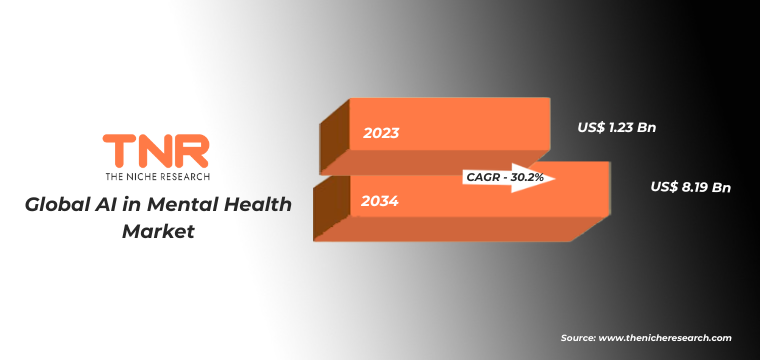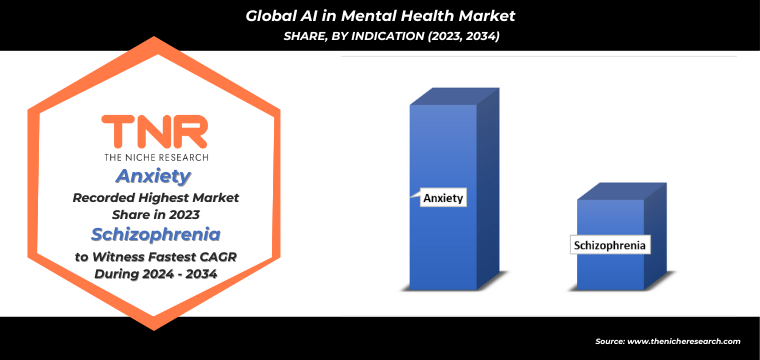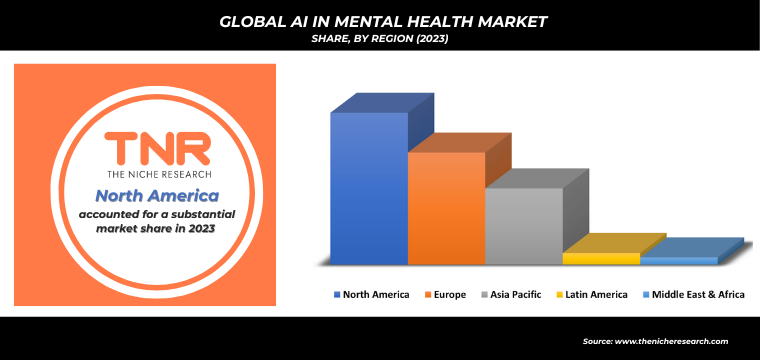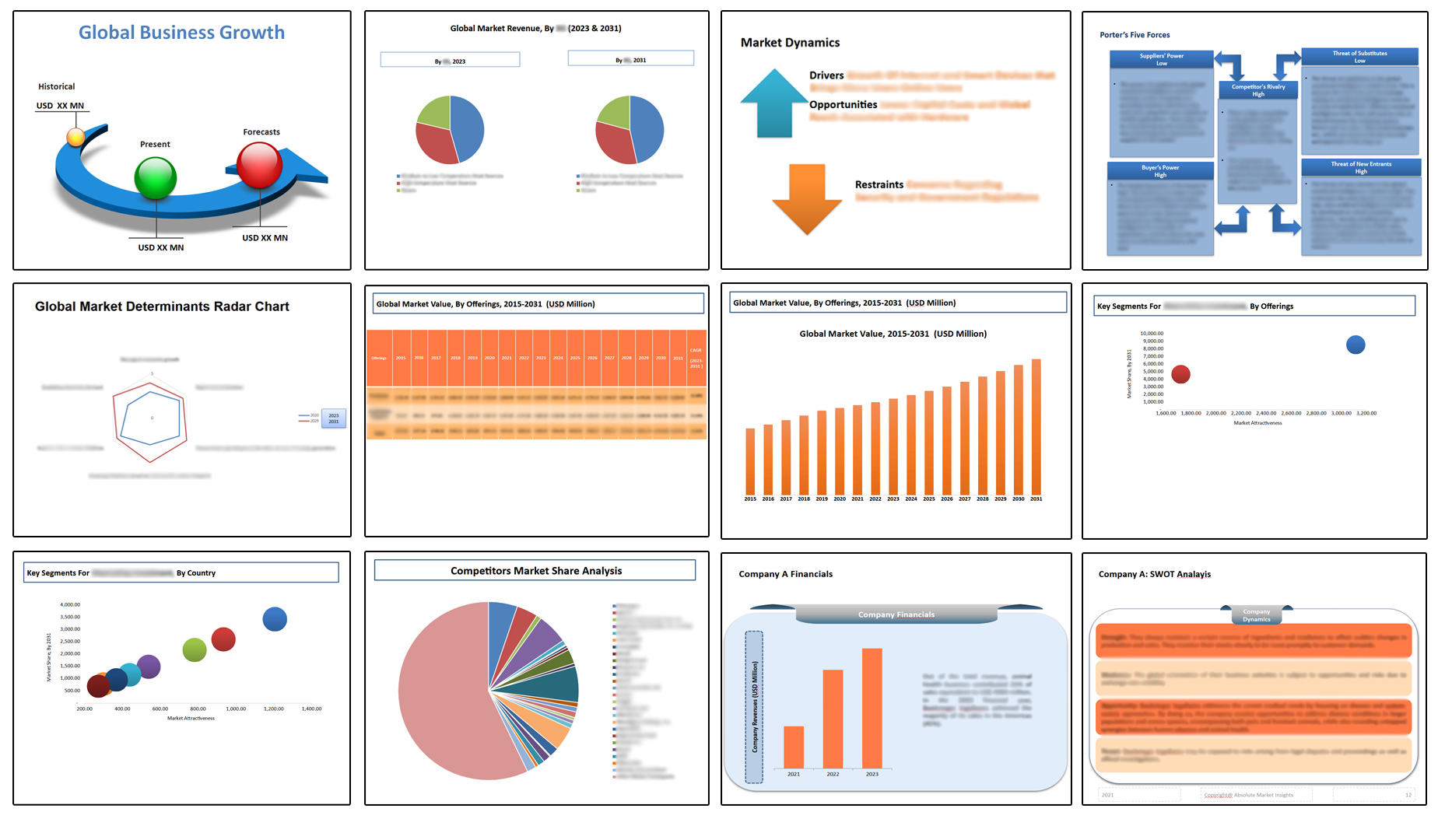Global AI in Mental Health Market By Technology, By Indication, By Therapy Type, By End User, By Region & Segmental Insights Trends and Forecast, 2024 – 2034
- Industry: Healthcare
- Report ID: TNR-110-1288
- Number of Pages: 420
- Table/Charts : Yes
- September, 2024
- Base Year : 2024
- No. of Companies : 10+
- No. of Countries : 29
- Views : 10087
- Covid Impact Covered: Yes
- War Impact Covered: Yes
- Formats : PDF, Excel, PPT
Mental health involves a person’s emotional, psychological, and social well-being. It affects how people think, feel, and behave, and is critical for managing stress, interacting with others, and making decisions. Mental health issues, such as depression, anxiety, and bipolar disorder, can disrupt daily life and require professional care.
AI in mental health helps by offering tools that can analyze large amounts of data to identify patterns, predict outcomes, and provide personalized care. For example, AI can assist in diagnosing mental health conditions by analyzing speech, text, and behavior patterns, offer real-time support through chatbots, and help clinicians create more tailored treatment plans. AI also enables remote monitoring and early intervention, making mental health care more accessible and efficient.
The global AI in Mental Health Market was valued at approximately USD 1.23 billion in 2023 and is projected to grow at a compound annual growth rate (CAGR) of 30.2% from 2024 to 2034. The growth of the market is chiefly fueled by rising awareness of mental health issues, the demand for scalable mental health care solutions, and the integration of AI-based tools by healthcare providers.

Global AI in Mental Health Market Key Trends
Growing Adoption of AI-Based Diagnostic Tools: AI-powered diagnostic tools are revolutionizing mental health care by providing clinicians with data-driven insights. These tools leverage machine learning algorithms to analyze patient data, including speech patterns, facial expressions, and behavioral data, to detect early signs of mental health disorders such as depression, anxiety, and bipolar disorder. For instance, companies like Ginger and Woebot are utilizing AI to provide real-time mental health support through chatbots, which can analyze text and voice inputs to assess emotional well-being.
Integration of AI in Teletherapy: The COVID-19 pandemic has accelerated the adoption of teletherapy, and AI is playing a crucial role in enhancing the effectiveness of remote mental health care. AI algorithms are being integrated into teletherapy platforms to monitor patients’ progress, provide personalized treatment recommendations, and even detect potential crises before they occur. Companies like Lyra Health and Talkspace are leading the way in incorporating AI into their teletherapy services, offering patients a more tailored and responsive care experience.
Advancements in Natural Language Processing (NLP) for Mental Health: Natural Language Processing (NLP) is a subset of AI that focuses on the interaction between computers and human language. In the context of mental health, NLP is being used to analyze patients’ speech and text for signs of distress or mental illness. NLP algorithms can identify keywords, tone, and sentiment in patient communications, providing clinicians with valuable insights into their mental state. This technology is particularly useful in assessing conditions like depression and anxiety, where patients may not always verbalize their feelings directly.
AI-Powered Mental Health Apps: The proliferation of mental health apps powered by AI is another significant trend in the market. These apps offer users a range of services, from mood tracking and meditation guides to cognitive-behavioral therapy (CBT) exercises and crisis support. AI enables these apps to offer personalized experiences based on users’ data, such as mood patterns, activity levels, and sleep quality. Notable examples include Calm, which uses AI to suggest personalized meditation sessions, and Youper, which employs AI to guide users through CBT exercises.
Segmental Data: Global AI in Mental Health Market

Natural Language Processing (NLP) has emerged as a dominant force in the AI in mental health market, representing over 39% of the total market share.
NLP’s prominence in the sector can be attributed to several key applications and advancements. One major factor is the development of advanced chatbots and virtual assistants, which leverage NLP to offer real-time therapeutic support. For example, Woebot, a popular mental health chatbot, reported that over 70% of its users experienced a significant reduction in symptoms of anxiety and depression within two weeks of use. Similarly, Wysa, another AI-driven mental health app, has seen over 1.5 million active users who benefit from its NLP-powered therapeutic interactions.
Sentiment analysis, a crucial application of NLP, also contributes to its significant market share. For instance, a study by Harvard University found that sentiment analysis tools powered by NLP can accurately detect depression with an accuracy rate of 80% based on social media data. This capability not only aids in early detection but also helps in tracking therapeutic outcomes, making NLP an essential tool for mental health professionals.
In addition to therapeutic applications, NLP is making strides in automating administrative tasks. According to a report by the American Psychological Association, NLP-driven transcription services have reduced the time spent on documenting patient interactions by approximately 40%. This efficiency allows mental health professionals to allocate more time to direct patient care, further boosting the adoption of NLP technologies.

In 2023, anxiety disorder emerged as the dominant focus within the AI in Mental Health market, reflecting the high prevalence and growing awareness of this condition. The significant attention to anxiety disorders is driven by both the widespread incidence of anxiety-related issues and the effectiveness of AI technologies in addressing these challenges.
Anxiety disorders affect approximately 1 in 13 people globally, according to the World Health Organization (WHO). This widespread prevalence translates into a substantial demand for effective management solutions. AI technologies, particularly those involving Natural Language Processing (NLP) and machine learning, have demonstrated remarkable efficacy in providing support and treatment for anxiety.
For example, AI-driven applications like Woebot and Wysa have become crucial tools in managing anxiety. Woebot, an AI chatbot designed to offer cognitive behavioral therapy (CBT), reported that users experienced a 60% reduction in anxiety symptoms within just a few weeks of use. Wysa, another notable app, has been adopted by over 1.5 million users and has received positive feedback for its ability to help users manage anxiety through real-time, evidence-based interventions.
Moreover, AI’s role in anxiety disorder management extends to predictive analytics and personalized treatment plans. Platforms leveraging machine learning algorithms can analyze vast amounts of data from user interactions, biometric sensors, and health records to identify patterns and predict anxiety episodes. For instance, a study published in the Journal of Medical Internet Research highlighted that AI models could predict anxiety attacks with an accuracy rate of up to 85% by analyzing behavioral data and physiological signals.
The effectiveness of AI in addressing anxiety disorders is further supported by its ability to provide scalable, accessible, and personalized care. AI-driven tools offer users immediate support, reducing wait times and making mental health care more accessible to those in need. The high engagement and positive outcomes reported by users of AI mental health apps underscore the growing reliance on these technologies to manage anxiety effectively.

Global AI in Mental Health Market: Regional Data
In 2023, North America commanded the largest revenue share of 42.4% in the AI in Mental Health market, reflecting its significant lead over other regions. This dominance is driven by a combination of high prevalence rates of mental health disorders, advanced technological infrastructure, substantial investments in AI research, and a supportive regulatory environment.
North America, particularly the United States and Canada, experiences a high prevalence of mental health disorders, including anxiety, depression, and substance abuse. According to the National Institute of Mental Health (NIMH), approximately 21% of U.S. adults experienced any form of mental illness in 2023. This high demand for mental health services drives the adoption of innovative solutions like AI to improve care delivery and accessibility.
In addition, North America is a global leader in AI research and development, with substantial investments from both the public and private sectors. In 2023, the U.S. alone invested approximately $21 billion in AI research, according to the National Science Foundation (NSF). Major tech companies, such as Google, Microsoft, and IBM, are heavily involved in developing AI technologies for mental health, contributing to the region’s dominant market share. It is also saw a 30% increase in venture capital investments in AI-driven mental health startups from 2022 to 2023.
North America Market Trends and Examples
- AI-Driven Mental Health Apps: The market is experiencing substantial growth in AI-driven mental health applications. For instance, BetterHelp and Talkspace, which leverage AI to match users with therapists and provide therapeutic interventions, have seen significant user growth. BetterHelp reported over 3 million active users in 2023, highlighting the increasing reliance on digital mental health solutions.
- Personalized Therapeutic Solutions: AI technologies are being used to develop personalized therapeutic solutions. For example, Woebot, an AI chatbot offering cognitive behavioral therapy (CBT), has been widely adopted, with over 1.5 million users in North America. The chatbot’s ability to provide personalized, on-demand support contributes to its popularity and reflects the trend towards tailored mental health care.
- Data-Driven Insights: AI’s capability to analyze large volumes of data for insights and predictions is a key trend. Companies like Mindstrong Health use AI to analyze behavioral data and provide insights into mental health conditions, improving diagnostic accuracy and treatment efficacy.
Global AI in Mental Health Market: Key Participants
- HEADSPACE HEALTH
- Lyra Health Inc
- Meru
- New Life Solution, Inc.
- Onebright
- Quartet
- Spring Care Inc
- Talkspace
- Woebot Health
- Wysa Ltd
- Other Industry Participants
Global AI in Mental Health Market: Key Insights
| Report Specifications | Details |
| Market Revenue in 2023 | USD 1.23 Bn |
| Market Size Forecast by 2034 | USD 8.19 Bn |
| Growth Rate (CAGR) | 30.2% |
| Historic Data | 2016 – 2022 |
| Base Year for Estimation | 2023 |
| Forecast Period | 2024 – 2034 |
| Report Inclusions | Market Size & Estimates, Market Dynamics, Competitive Scenario, Trends, Growth Factors, Market Determinants, Key Investment Segmentation, Product/Service/Solutions Benchmarking |
| Segments Covered | By Technology, By Indication, By Therapy Type, By End User |
| Regions Covered | North America, Europe, Asia Pacific, Middle East & Africa, Latin America |
| Countries Covered | U.S., Canada, Mexico, Rest of North America, France, The UK, Spain, Germany, Italy, Nordic Countries (Denmark, Finland, Iceland, Sweden, Norway), Benelux Union (Belgium, The Netherlands, Luxembourg), Rest of Europe, China, Japan, India, New Zealand, Australia, South Korea, Southeast Asia (Indonesia, Thailand, Malaysia, Singapore, Rest of Southeast Asia), Rest of Asia Pacific, Saudi Arabia, UAE, Egypt, Kuwait, South Africa, Rest of Middle East & Africa, Brazil, Argentina, Rest of Latin America |
| Key Players | HEADSPACE HEALTH, Lyra Health Inc, Meru, New Life Solution, Inc., Onebright, Quartet, Spring Care Inc, Talkspace, Woebot Health, Wysa Ltd., Other Market Participants |
| Customization Scope | Customization allows for the inclusion/modification of content pertaining to geographical regions, countries, and specific market segments. |
| Pricing & Procurement Options | Explore purchase options tailored to your specific research requirements |
| Contact Details | Consult With Our Expert
Japan (Toll-Free): +81 663-386-8111 South Korea (Toll-Free): +82-808- 703-126 Saudi Arabia (Toll-Free): +966 800-850-1643 United Kingdom: +44 753-710-5080 United States: +1 302-232-5106 E-mail: askanexpert@thenicheresearch.com
|
Global AI in Mental Health Market:
By Technology
- Chatbots
- Virtual reality therapy
- Wearable sensor
- Machine learning-based diagnosis
- Natural language processing (NLP)
- Computer vision
- Others
By Indication
- Addiction
- Alcohol Addiction
- Food Addiction
- Sex Addiction
- Gambling Addiction
- Others
- Anxiety
- Health anxiety
- Anxiety in children and teens
- Work and public speaking anxiety
- Others
- Depression
- Postnatal & Postpartum depression
- Depression in pregnancy
- Depression in relationships
- Work depression
- Others
- Phobia
- Bipolar Affective Disorder
- Panic Attacks
- Pain Management
- OCD
- Schizophrenia
- Others
By Therapy Type
- Online therapy
- Face-to-face therapy
- Self-guided therapy
By End User
- Individuals
- Business
- Consultancy
- Hospitals and Clinics
- Corporate
- Providers
- Mental Health Providers
- Referring Providers
- Others
By Region
- North America (U.S., Canada, Mexico, Rest of North America)
- Europe (France, The UK, Spain, Germany, Italy, Nordic Countries (Denmark, Finland, Iceland, Sweden, Norway), Benelux Union (Belgium, The Netherlands, Luxembourg), Rest of Europe
- Asia Pacific (China, Japan, India, New Zealand, Australia, South Korea, Southeast Asia (Indonesia, Thailand, Malaysia, Singapore, Rest of Southeast Asia), Rest of Asia Pacific
- Middle East & Africa (Saudi Arabia, UAE, Egypt, Kuwait, South Africa, Rest of Middle East & Africa)
- Latin America (Brazil, Argentina, Rest of Latin America
Global AI in Mental Health Market Layout

Table of Contents
Note: This ToC is tentative and can be changed according to the research study conducted during the course of report completion.
**Exclusive for Multi-User and Enterprise User.
Global AI in Mental Health Market:
By Technology
- Chatbots
- Virtual reality therapy
- Wearable sensor
- Machine learning-based diagnosis
- Natural language processing (NLP)
- Computer vision
- Others
By Indication
- Addiction
- Alcohol Addiction
- Food Addiction
- Sex Addiction
- Gambling Addiction
- Others
- Anxiety
- Health anxiety
- Anxiety in children and teens
- Work and public speaking anxiety
- Others
- Depression
- Postnatal & Postpartum depression
- Depression in pregnancy
- Depression in relationships
- Work depression
- Others
- Phobia
- Bipolar Affective Disorder
- Panic Attacks
- Pain Management
- OCD
- Schizophrenia
- Others
By Therapy Type
- Online therapy
- Face-to-face therapy
- Self-guided therapy
By End User
- Individuals
- Business
- Consultancy
- Hospitals and Clinics
- Corporate
- Providers
- Mental Health Providers
- Referring Providers
- Others
By Region
- North America (U.S., Canada, Mexico, Rest of North America)
- Europe (France, The UK, Spain, Germany, Italy, Nordic Countries (Denmark, Finland, Iceland, Sweden, Norway), Benelux Union (Belgium, The Netherlands, Luxembourg), Rest of Europe
- Asia Pacific (China, Japan, India, New Zealand, Australia, South Korea, Southeast Asia (Indonesia, Thailand, Malaysia, Singapore, Rest of Southeast Asia), Rest of Asia Pacific
- Middle East & Africa (Saudi Arabia, UAE, Egypt, Kuwait, South Africa, Rest of Middle East & Africa)
- Latin America (Brazil, Argentina, Rest of Latin America
The Niche Research approach encompasses both primary and secondary research methods to provide comprehensive insights. While primary research is the cornerstone of our studies, we also incorporate secondary research sources such as company annual reports, premium industry databases, press releases, industry journals, and white papers.
Within our primary research, we actively engage with various industry stakeholders, conducting paid interviews and surveys. Our meticulous analysis extends to every market participant in major countries, allowing us to thoroughly examine their portfolios, calculate market shares, and segment revenues.
Our data collection primarily focuses on individual countries within our research scope, enabling us to estimate regional market sizes. Typically, we employ a bottom-up approach, meticulously tracking trends in different countries. We analyze growth drivers, constraints, technological innovations, and opportunities for each country, ultimately arriving at regional figures.Our process begins by examining the growth prospects of each country. Building upon these insights, we project growth and trends for the entire region. Finally, we utilize our proprietary model to refine estimations and forecasts.
Our data validation standards are integral to ensuring the reliability and accuracy of our research findings. Here’s a breakdown of our data validation processes and the stakeholders we engage with during our primary research:
- Supply Side Analysis: We initiate a supply side analysis by directly contacting market participants, through telephonic interviews and questionnaires containing both open-ended and close-ended questions. We gather information on their portfolios, segment revenues, developments, and growth strategies.
- Demand Side Analysis: To gain insights into adoption trends and consumer preferences, we reach out to target customers and users (non-vendors). This information forms a vital part of the qualitative analysis section of our reports, covering market dynamics, adoption trends, consumer behavior, spending patterns, and other related aspects.
- Consultant Insights: We tap into the expertise of our partner consultants from around the world to obtain their unique viewpoints and perspectives. Their insights contribute to a well-rounded understanding of the markets under investigation.
- In-House Validation: To ensure data accuracy and reliability, we conduct cross-validation of data points and information through our in-house team of consultants and utilize advanced data modeling tools for thorough verification.
The forecasts we provide are based on a comprehensive assessment of various factors, including:
- Market Trends and Past Performance (Last Five Years): We accurately analyze market trends and performance data from preceding five years to identify historical patterns and understand the market’s evolution.
- Historical Performance and Growth of Market Participants: We assess the historical performance and growth trajectories of key market participants. This analysis provides insights into the competitive landscape and individual company strategies.
- Market Determinants Impact Analysis (Next Eight Years): We conduct a rigorous analysis of the factors that are projected to influence the market over the next eight years. This includes assessing both internal and external determinants that can shape market dynamics.
- Drivers and Challenges for the Forecast Period:Identify the factors expected to drive market growth during the forecast period, as well as the challenges that the industry may face. This analysis aids in deriving an accurate growth rate projection.
- New Acquisitions, Collaborations, or Partnerships: We keep a close watch on any new acquisitions, collaborations, or partnerships within the industry. These developments can have a significant impact on market dynamics and competitiveness.
- Macro and Micro Factors Analysis:A thorough examination of both macro-level factors (e.g., economic trends, regulatory changes) and micro-level factors (e.g., technological advancements, consumer preferences) that may influence the market during the forecast period.
- End-User Sentiment Analysis: To understand the market from the end-user perspective, we conduct sentiment analysis. This involves assessing the sentiment, preferences, and feedback of the end-users, which can provide valuable insights into market trends.
- Perspective of Primary Participants: Insights gathered directly from primary research participants play a crucial role in shaping our forecasts. Their perspectives and experiences provide valuable qualitative data.
- Year-on-Year Growth Trend: We utilize a year-on-year growth trend based on historical market growth and expected future trends. This helps in formulating our growth projections, aligning them with the market’s historical performance.
Research process adopted by TNR involves multiple stages, including data collection, validation, quality checks, and presentation. It’s crucial that the data and information we provide add value to your existing market understanding and expertise. We have also established partnerships with business consulting, research, and survey organizations across regions and globally to collaborate on regional analysis and data validation, ensuring the highest level of accuracy and reliability in our reports.









